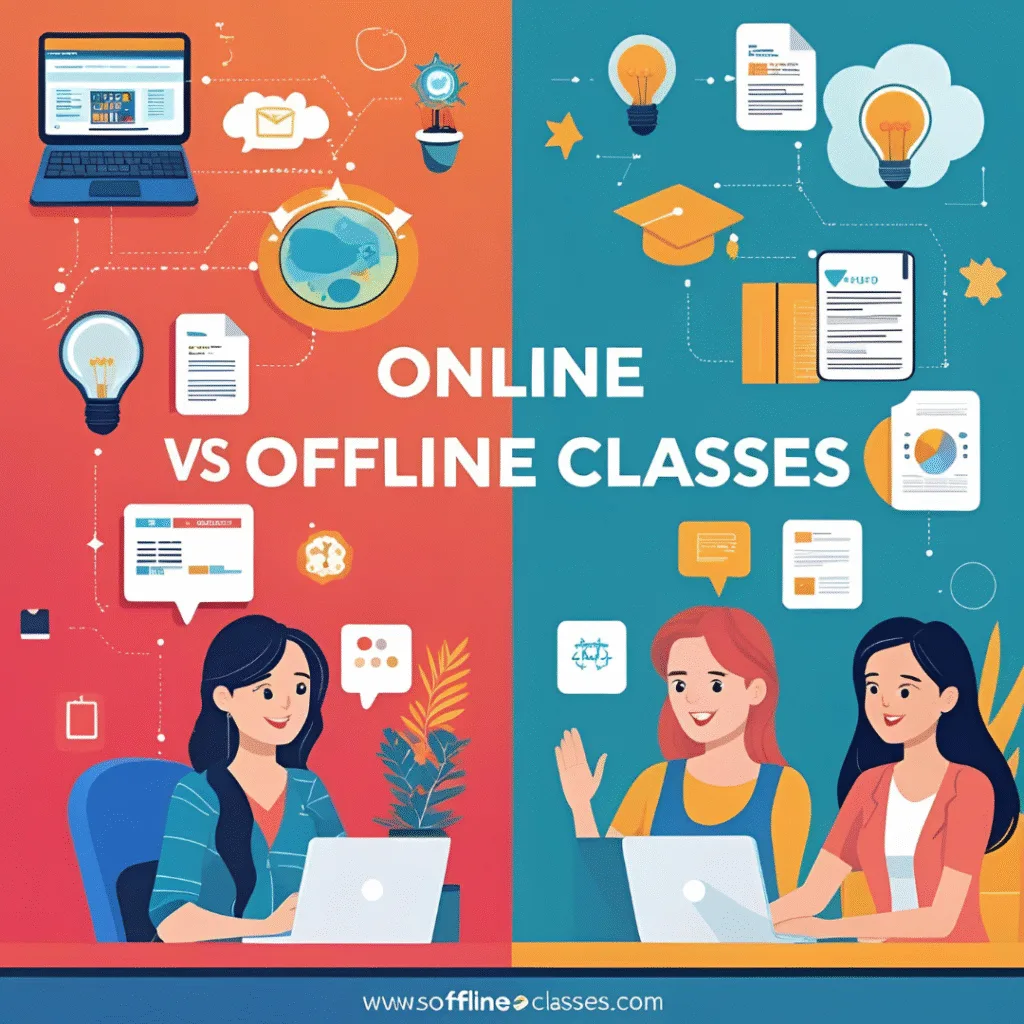
Introduction
The debate between online vs offline Classes has transformed dramatically as India’s online education market valuation jumped from INR 91.41 billion in 2020 to an expected INR 325.48 billion by 2026. This remarkable growth certainly raises questions about which educational approach better serves today’s learners.
When comparing online vs offline Classes, we can’t ignore the significant advantages that digital learning offers. Flexibility, convenience, and cost-effectiveness have become major factors in students’ decisions. Furthermore, the elimination of commuting time and 24/7 access to academic resources make online learning increasingly attractive for many.
In this article, I’ll explore the hidden truths about both learning methods in 2025, examining why online education is gaining momentum and how it helps students develop valuable technical skills that employers actively seek. We’ll also look at the key differences in learning environments, teaching methods, and what the future might hold for education as a whole.
Understanding Online Vs Offline Classes
Education has undergone a fundamental shift in how knowledge is delivered and received. Let’s explore the core differences between learning methods and how they’ve evolved by 2025.
What is online education and what is the difference between online vs offline classes?
Online education refers to learning that takes place via the internet, removing traditional time and space limitations. This approach includes live virtual classes, pre-recorded lectures, interactive quizzes, and digital assessments. The accessibility of online education has made it increasingly popular, with approximately 75% of all undergraduate students in the United States enrolled in at least one online course as of fall 2020
Online learning enables students to study from anywhere, making it ideal for balancing work, family, and other commitments. In addition to flexibility, this model offers self-paced learning, allowing students to grasp concepts at their own speed. Many platforms provide students with the opportunity to revisit materials through recorded audio and video, whereas missing a class in an offline setting might mean missing key learning milestones.
What is offline education?
Offline education, commonly known as traditional classroom learning, represents teaching that requires students and instructors to be present at the same time and place. This model involves face-to-face interactions in physical schools, structured schedules, and the use of physical resources like textbooks and whiteboards.
The classroom environment promotes direct teacher-student interaction, fostering social skills, discipline, and routine. Particularly beneficial for courses requiring practical training and hands-on experience, offline education provides the necessary tools for specialised learning in fields like medicine and engineering.
How learning has evolved in 2025 with online vs offline classes
In 2025, education has moved beyond the either/or approach to learning. Hybrid models have become increasingly prevalent, combining the strengths of both online and offline education. According to UNESCO, over 70% of universities worldwide now integrate online resources into their traditional courses.
The educational landscape has shifted toward a more dynamic, technology-enhanced approach. Virtual and augmented reality have transformed learning experiences, allowing students to explore complex subjects through immersive technology. Meanwhile, AI-powered chatbots and virtual tutors have become commonplace, offering instant academic support.
Essentially, the distinction between online and offline classes has blurred, with the focus now on creating comprehensive frameworks that deliver the best of both worlds—combining the flexibility and technological advantages of online learning with the social interaction and hands-on benefits of traditional classrooms.

Key Advantages of Online Learning
Online learning offers unmatched benefits that traditional classrooms simply cannot provide. Let’s explore what makes this approach so attractive for millions of students worldwide.
1. Flexibility in time and location
The primary appeal of online education is its remarkable flexibility. More than half of online learners have children at home or are currently working, making scheduling freedom essential. Studies show that online students can cover five times more course material than those in traditional settings, primarily because they can learn when it’s most convenient—evenings, weekends, or even during lunch breaks. Thus online platforms has an edge when comparing online vs offline classes.
2. Convenience and no commute
Gone are the stressful commutes through traffic or bad weather. Online learning eliminates daily travel to campus, saving valuable time and reducing transportation costs. This saved time can be redirected toward studying, family time, or career development. Moreover, students can literally “roll out of bed and log onto their computer“, making education accessible even on challenging days.
3. Personalised learning pace
In 2025, online classes will have become much more advanced than simple video lectures. It has many advantages and has become a popular choice for learners. Its biggest advantage is that students get flexibility to access course work. They can acquire education anytime and from anywhere according to their time. Or it is very beneficial for especially working professional parents and those who live in remote areas and traditional education is not accessible. Along with technological advancement, Virtual Reality CR and Augmented Reality AR have changed online learning in a lot of ways and now it has become a unique experience.
4. Access to Both offline and online lectures
In 2025, both online and offline education modes are quite popular and the most popular among these is the hybrid mode in which students not only have online classes but also offline classes and at the same time they can access online video lectures and revise every topic again. If due to any reason the students have a backlog, then they can revise it through online video lectures and understand the lecturers. Nowadays, online platforms are also used to clear doubts. This helps in resolving the problems of the students easily and the students can clear the doubts that come from home.
More Reasons Why Online Wins
In today’s dynamic world, online platforms have emerged as numerous compelling reasons in comparison to online and traditional methods. Its major advantage and convenience is that all types of products, services, courses and lecturers can be viewed and understood with just a few clicks and there is also saving of traveling cost and time. Apart from this, online environment is full of large variety and customization.
5. Interactive and engaging tools
The online environment can be made very engaging. Through video games and interactive tools, the online platform can be made very entertaining and informative and it also generates interest in the students towards the courses. They participate in the activity with more interest and can easily understand the complex concepts.
6. Benefits of offline classes in a tech-driven era
Despite the advancement of online learning platforms for technology, offline classes still play an important role, especially in the tech driving landscape of 2025. Its most important contribution is the opportunity for face-to-face interaction and immediate communication and personal connection between students and instructors. It allows for ideal timely feedback. Educational activities and practical work in the science and technology labs can be easily done. It gives an edge to offline classes as compared Online Vs Offline Classes.
7. the role of hybrid learning model
As education is transformed, hybrid learning models are emerging as a powerful solution that combines the best of online and offline classes and offers students flexibility and the opportunity to participate in activities and practicals in person.
With the development of technology, the classroom is evolving so that children get the opportunity to gain good knowledge and understand practical knowledge well despite the facilities of physical location. The hybrid model works as a tool to fill the gap between education to monitor data analytics, which makes it very dynamic, effective and student-centered in today’s tech driving world.
8. Lower overall costs
The financial advantages of online education are compelling. For public 4-year colleges, an online degree is approximately $30,545 cheaper than an out-of-state traditional degree. Private institutions show even more dramatic savings, charging on average $62,756 for an online degree versus $198,616 for an in-person experience.
Notably, some institutions offer significant tuition discounts for online programs—like Drexel University’s School of Education, which provides a 25% reduction off regular tuition rates.
8. Builds digital and technical skills
In today’s digital economy, proficiency with online tools is essential. The online learning experience itself builds crucial digital literacy skills highly valued by employers, with 87% identifying digital communication and collaboration as key competencies for new hires.
- Online education helps students develop exceptional organisation and time management abilities. Taking courses online requires personal drive and a proactive approach—qualities that translate directly to workplace success.
- Most significantly, as remote work becomes increasingly common, the skills gained through navigating digital learning platforms transfer perfectly to professional settings. According to research, employers now view online credentials as equivalent to in-person programs, with leaders believing that digital credentials demonstrate both initiative and valuable employee skills.
Online vs Offline: A Direct Comparison
When examining educational approaches head-to-head, several critical factors differentiate online from offline learning experiences. Let’s explore these distinctions across four fundamental aspects.
Learning environment and structure
An important thing that comes to light by comparing online and offline platforms is that online platforms provide a battle opportunity as well as flexibility of timing, students can learn according to their time and can enhance their knowledge, it also proves to be a boon for working professionals and parents who want to update their skills. On the contrary, offline platforms also have some special features, important among them are 121 interactions and practical knowledge, as well as in offline platforms, students get a social support which is not there in online platforms, as well as there are many distractions in online platforms which are not there in offline platforms and students can easily learn by seeing and understanding things face to face.
Assessment and feedback methods
Assessment and feedback methods are vital for effective learning. They provide valuable insights into educational development and interaction between instructors and learners. Different assessment techniques such as formative assessment, committee evaluation, self-assessment, and peer reviews help in developing different understandings and skills. Formative assessments such as quizzes, in-class activities, and real-time feedback are very helpful.

Accessibility and inclusivity
In the modern educational era, inclusivity platforms are an important way to create an equitable learning environment for offline and online classes that provides a differentiated learning environment for students irrespective of their abilities and disabilities. Sign language interpreters for disabled students, smart boards for online classes have become easily available and accessible to students, and digital platforms have become much easier not only for students but also for educators and learning activities have improved significantly.
Role of AI and automation in learning
AI technologies are fundamentally reshaping how we teach and learn. The AI education market, valued at $4 billion in 2022, is projected to reach $30 billion by 2032 Online Vs offline. These sophisticated systems create immersive learning environments through virtual reality and augmented reality, enabling students to explore complex concepts in unprecedented ways Online vs offlline classes. Beyond enhancing student experiences, AI handles administrative tasks like grading, allowing educators to focus on meaningful student engagement. Intelligent tutoring systems identify knowledge gaps, offer additional materials, and adapt learning pace to individual needs.
Changing expectations from students and employers
Today’s students seek more than just academic credentials—they want meaningful, personalised learning journeys. Amidst inflation concerns and economic uncertainty, graduates prioritise financial benefits, debt repayment assistance, and mental health support. Simultaneously, employer demands are shifting dramatically. According to NACE’s Job Outlook 2025, fewer than 40% of employers now screen candidates by GPA. Instead, approximately 65% utilise skills-based hiring practices, seeking graduates who demonstrate adaptability, ethical judgment, and technical proficiency. This shift emphasises the importance of developing both practical skills and professional attributes that transfer across diverse work environments.
Conclusion
The educational landscape has clearly shifted dramatically since 2020, blurring the lines between traditional and digital learning approaches. Therefore, both students and institutions must adapt to this new reality where flexibility and personalised experiences matter most. Online education offers undeniable advantages – time flexibility, cost savings, diverse course options, and technical skill development that employers increasingly value.
Nevertheless, offline education still holds significant merit through its structured environment, immediate feedback, and stronger social connections. Students who thrive on face-to-face interactions and hands-on learning might find traditional classrooms better suited to their needs.
Actually, the future of education lies not in choosing one approach exclusively but rather embracing hybrid models that combine strengths from both worlds. This balanced approach addresses the “online fatigue” many students experience while still providing the convenience digital learning offers.
Above all, education in 2025 focuses less on where learning happens and more on effectiveness, engagement, and outcomes. AI integration, changing employer expectations, and evolving student needs continue to reshape what education means. The institutions that thrive will be those offering flexible, personalised learning journeys that prepare students for real-world success.
Whether online Vs offline Classes, or somewhere in between, the ultimate goal remains the same—creating meaningful learning experiences that develop knowledgeable, skilled individuals ready to tackle tomorrow’s challenges. The choice between learning methods will undoubtedly depend on individual circumstances, learning styles, and career aspirations.



I must say this article is extremely well written, insightful, and packed with valuable knowledge that shows the author’s deep expertise on the subject, and I truly appreciate the time and effort that has gone into creating such high-quality content because it is not only helpful but also inspiring for readers like me who are always looking for trustworthy resources online. Keep up the good work and write more. i am a follower.
I appreciate you liked this. Thanks a ton.